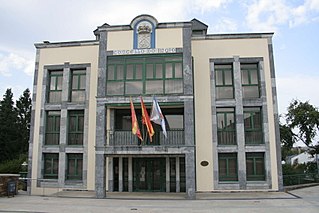
Lusitania or Hispania Lusitana was an ancient Iberian Roman province located where modern Portugal and part of western Spain lie. It was named after the Lusitani or Lusitanian people.

Lugo is a province of northwestern Spain, in the northeastern part of the autonomous community of Galicia. It is bordered by the provinces of Ourense, Pontevedra, and A Coruña, the principality of Asturias, the State of León, and in the north by the Cantabrian Sea.

Gallaecia, also known as Hispania Gallaecia, was the name of a Roman province in the north-west of Hispania, approximately present-day Galicia, northern Portugal, Asturias and Leon and the later Suebic Kingdom of Gallaecia. The Roman cities included the port Cale (Porto), the governing centers Bracara Augusta (Braga), Lucus Augusti (Lugo) and Asturica Augusta (Astorga) and their administrative areas Conventus bracarensis, Conventus lucensis and Conventus asturicensis.

In ancient Roman religion, a lucus is a sacred grove.
The Coelerni were an ancient Celtic tribe of Gallaecia in Hispania, part of Calaician or Gallaeci people, living in what was to become the Roman Province of Hispania Citerior, convent of Bracara Augusta, in what is now the southern part of the province of Ourense.

Legio septima Gemina was a legion of the Imperial Roman army. It was founded in AD 68 in Hispania by the general Galba to take part in his rebellion against the emperor Nero. "Gemina" means the legion was dedicated to the legendary twin founders of Rome, Romulus and Remus, who were suckled by a she-wolf. The legion was deployed in the city called Legio in AD 74 and remained in Hispania to the end of the 4th century.

Luc-en-Diois is a commune in the Drôme department in southeastern France. It is situated on the Drôme River.
Lucus Augusti is the Latin name of two different ancient places in the Roman Empire:

O Incio is a municipality in the province of Lugo in Galicia in north-west Spain.

Palas de Rei is a town in the province of Lugo, Galicia in northwestern Spain. It belongs to the comarca of A Ulloa.

Cilicia was an early Roman province, located on what is today the southern (Mediterranean) coast of Turkey. Cilicia was annexed to the Roman Republic in 64 BC by Pompey, as a consequence of his military presence in the east, after pursuing victory in the Third Mithridatic War. It was subdivided by Diocletian in around 297, and it remained under Roman rule for several centuries, until falling to the Islamic conquests.
Paullus Fabius Maximus was a Roman senator, active toward the end of the first century BC. He was consul in 11 BC as the colleague of Quintus Aelius Tubero, and a confidant of emperor Augustus.

The Roman walls of Lugo were constructed in the 3rd century and are still largely intact, stretching over 2 kilometers around the historic centre of Lugo in Galicia (Spain). The fortifications were added to UNESCO's World Heritage List in late 2000 and are a popular tourist attraction.
Sunieric was a Visigoth general, who collaborated with the Roman army in the re-conquest of Spain on behalf of Emperor Majorian.

The Conventus bracarensis, was a Roman administrative unit located in the northwest of the Iberian Peninsula, in Gallaecia. Its name derives from its capital Bracara Augusta, a citadel established by the Romans, which became the convent's administrative center. Its southern limit was the river Douro, it marked the streak with the Roman province of Lusitania. In the north, its limits were the river Verdugo, and the river Sil, both marked the border with the Conventus lucensis. Its eastern borders were marked by the river Navea, a tributary of the Sil, that limited with the Conventus asturicensis.
According to Strabo, the Artabri were an ancient Gallaecian Celtic tribe, living in the extreme north-west of modern Galicia, about Cape Nerium, outskirts of the city and port of Ferrol, where in Roman times, in the 1st century BC, a fishing port existed which also trade in metals as well as wild horsesin the bay of Ferrol most likely administered from nearby Nerium in an area dominated by the Artabri ) giving name to the Portus Magnus Artabrorum. Strabo reports several seaports among the Artabri. Ptolemy places them among Galaeci Lucenses and gives their capital town as Lucus Augusti.
Arde Lucus (Burn Lugo) is a festival celebrated in Lugo in the last weeks of June which revives the Roman and castro past of the city, and which emerged to commemorate the declaration of the city's Roman wall as a World Heritage Site in 2000. In its latest editions it has reached nearly half a million visitors.

Scallabis was the Roman name of Santarém, Portugal.

The Battle of the Nervasos Mountains occurred in the year 419 and was fought between a coalition of Suebi, led by King Hermeric together with allied Roman Imperial forces stationed in the Province of Hispania, against the combined forces of the Vandals and Alans who were led by their King Gunderic. This battle occurred in the context of a contemporary Germanic invasion of the Iberian Peninsula. The battle took place in what is today the Province of León, Spain, and resulted in a Roman/Suebian Victory.














